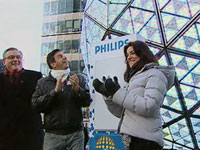Even surrounded by the visual overload that is Times Square on New Year’s Eve, the Ball is hard to miss. Yes folks, not only is it big — 12 feet in diameter and weighing 11,875 pounds — it’s also very, very bright.
Now, thanks to Philips, the supplier of its lights, you also know exactly how many LEDs it takes to give the iconic spectacle its glow: 32,256. And each is computer controlled to produce fancy effects behind a shell of Waterford crystal.
The LEDs are 88 percent more efficient than its prior light source, requiring the equivalent energy of two home ovens to keep running for an hour. Plus, they’re expected to operate 30,000 hours, far above and beyond the roughly 1,000 hours that prior halogens and incandecents could muster.
All neat stuff, but this year the Ball carries with it some extra symbolism, according to the company.
Countdown to EISA
On January 1, 2012, the Energy Independence & Security Act 2007 goes into effect. For LED lighting manufacturers, it’s expected to become a major — if not the major — turning point for the industry. While many factors are contributing to its growing popularity, LED lighting is poised to really take off when regulations begin pushing market conditions in favor of energy efficient light sources.
And considering that Philips expects LEDs to comprise 10 percent of the global lighting market this year — the U.S. happens to be the prime market for LED lighting, representing 40 percent global share — there’s a lot of room for growth.
Looks like a bright New Year, both at Times Square and for LED companies, doesn’t it?
Image credit: Philips


Leave a Reply